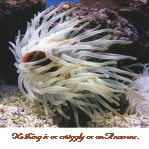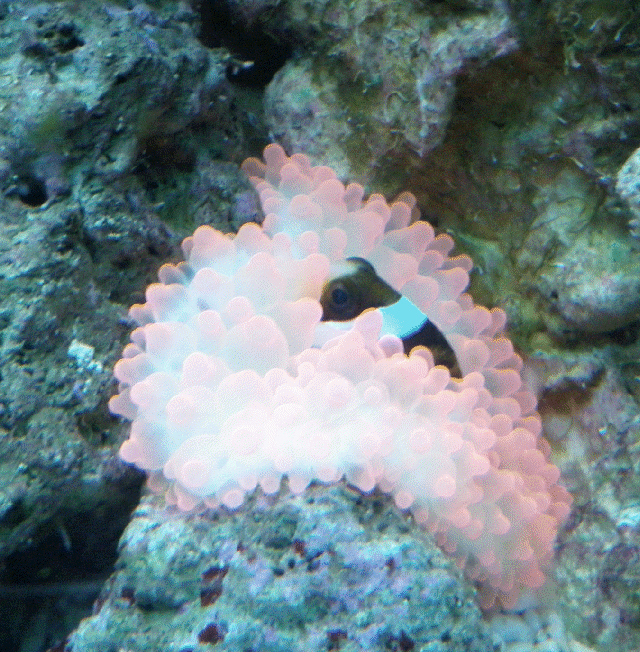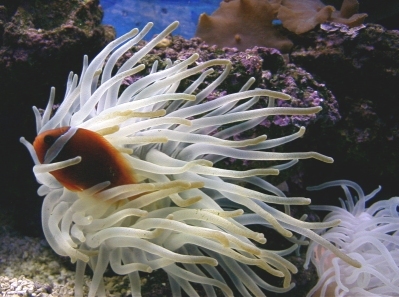


My old sebae clownfish had never had an anemone. He was 5 or 6 years old, I think I got him in 2006, and he had popeye
that wasn't responding to treatment in quarantine. I think he got it trying to feed and nurture my brittle star.
I have never seen any creature as happy as he was when I put his rose anemone in the tank in early October 2011.
He only lived 2 more months. Died last week (around 2 months after I added the anemone). But the popeye had cleared on its own after a week dancing in anemone tentacles.
His joy gave me joy.

I have learned a couple of things about anemones from this one. Today is January 9, 2013. Had the same anemone for over a
year. I suspect consistent DI water to mix salt with, and algone pouches if the tank starts looking rough are probably
helping. And, my rose anemone, is now 2 rose anemones, and one of
those is looking like it will do a 3 way split. (when it divided it split into 3 but only 2 had enough body to survive the
split.)I'm getting away with the one water change a month I have time for. AND
I am now allergic to anemones. I have to wear shoulder high gloves to either feed the anemones or service the tank, or
I get a very horrible rash on my inner arm starting the next day. Guess I won't be swimming in the ocean.
The last weekend in July 2013 I gave my oldest daughter my reef tank. Wearing a shoulder high glove to feed and service
was not making it enjoyable, and I wasn't keeping it as clean because of the hassle. I hope she and my granddaughter
enjoy it very much. I miss it, but having 'kalkwassered' the tank every day for years, I'll get over it.
Marine parasite photos - coral beauty angel 2009. 
I got about 8 pics,
but owing to the curved measuring cup, and moving fish, most aren't very good.
Tales of the indoor world of saltwater aquariums. Everything Fishy, well that would actually just be I, used to stock and maintain several highly successful marine aquariums running on relatively inexpensive equipment. Because my quarantine process was sound, the fish were healthy, did not die of parasites, and the tanks remained beautiful. But along came the competition, promising lower prices, and I lost the tanks due to my costs. I use (to this day) almost nothing but Reef Crystals. I will use 10 gallons of mixed Reef Crystals to 5 gallons mixed with Fritz salt mix on my 55 gallon tank for its water change. The competition was using cheaper salt, skipping quarantine, and cutting price accordingly. So all of the beautiful fish I quarantined over the years lost their lives to introduced parasites, or parasites left on live rock from the prior service company when I took the tank over and the owner could not bear to wait the time it takes to starve fish parasites out of a reef.
In other words, I really love fish, and I got my heart broken over a few.
Then we had the tsunami of Dec 27, 2004, and every fish I bought on Feb 1st 2005 died. I still had a couple of salt accounts at the time, so it was a die-off in the hundreds of dollars. Actually every fish anyone bought in early 2005 was short-lived, as a new form of ich was stirred from the ocean floor to infect the reef fish caught in Indonesia, and that parasite scoffed at copper-based medicines. New organic medicines came out, and according to my regal tang (who survived infection and many treatment tests) all of them were snake oil.
I slapped a UV light on the one customer tank I had managed to infect via his regal tang, and after 3 months at low salinity with UV his fish were healthy again. A few months later a competitor would come in with a cut-rate price a few new fish, and kill off all of the fish I'd saved.
I also dipped my regal tang in freshwater every week or so, and I tested the new hot snake oil treatments without UV on him until all were
obviously failures. Then I dipped him again, and put a UV light on his tank - and saved him. He is the same regal tang I still have in 2010
(but he's much larger today.)
I went back to basics with my tang at home, and in August 2005 bought a gorgeous little pygmy angel who kept me company for 3 or 4 years.
Now and then I get a saltwater aquarium call. And with guilt in my heart, I suggest one of the other companies that I know don't
quarantine properly, they just bring new fish when the old ones die. Great guilt - because we are depleting the reefs using fish
as furniture in customers' aquariums, particularly when we do not treat the diseases that multiply like wildfire in such a small space.
(compared to a reef of course)
Today, as I updated the aquarium service site, I needed a place to put the beautiful pictures of all the fish I have known and loved and
actually managed to get a picture of. My rogue's gallery is very incomplete, I had so little time to enjoy my babies except when
they were in my quarantine tanks. (And my quarantine tanks are anything but photogenic, just don't do them justice.) I
donated my own large marine betta and very large well-fed yellow tang who ate all my beautiful marine plants to the Fort Worth zoo,
just a few weeks before they closed the aquarium building and shipped all of the fish off to points unknown.
Anyway, enjoy the pics and the stories, you fellow marine addicts - we know that blood is salty and so is the ocean, and the kinship is
indeed like an addiction. No, I no longer service marine aquariums. But if you have an odd problem, disease or syndrome, you can drop me an
email and I might have the answer you are chasing. Or know who does.
Thanks for reading this. I enjoyed writing it. The pleasure and beauty received from a healthy reef far surpasses the time,
dedication and dollars it takes to keep it up. For me anyway.
Alice Burkhart
Everything Fishy
Anemones are fun.
They do unexpected and occasionally stupid things, like trying to explore the pump intake with their tentacles. One of the anemones in the photo survived the HOT Magnum, chiefly because I got home and unplugged it, then let the anemone spend 3 days removing its own tentacles. They enjoy $9.00 a pound shrimp and guppies. They climb the walls and prevent decent water changes. They flush themselves out and scare you to death. And they are marvelous indicators for the condition of your reef tank. The anemone often provides the first visible clue that a contaminant has gotten into the tank, or a pump has been left unplugged and caused an ammonia spike.
Anemones are intolerant of dechlorinated tap water's hidden contaminants, and dislike the buffers required to get tap water to hold pH. Getting one to live for over a year has meant learning and re-learning marine chemistry, refining my understanding of minimum maintenance, water conditions, lighting, supplements, etc. It meant going to nothing but RO on water changes, switching the skimmer. (VisiJet is much better than a back mounted air driven counter current, and the new one is better still.) Coral Vital has produced marvelous changes in the vitality and lifespan of all my corals, and the anemones seem to approve of it. (Coral Vite smells like my chemical vitamin B6 supplement. It flunked the test.) Getting anemones to thrive also meant removing all anemone predators from my reef, one at a time. I wouldn't be surprised to find a few bristleworms are still in there, but all the crabs, from small to large, are gone. The chocolate chip starfish is gone. The pencil urchin is gone. (The urchin was actually after the corals rather than the anemone.) One of the clownfish has moved to another tank, to prevent fighting too near the anemones. These are obviously my pampered pets or total addictions. The quality of the digital camera was dictated by the desire for an anemone T-shirt. The color printer was necessary to print the image for the shirt. And it goes on and on. Here are the photos.
Tank: 55 gal reef with u/g, 2 powerheads, HOT Magnum, VisiJet Skimmer, Homemade Normal Output 3 bulb, 120 watt fixture, 1 actinic, 2 balanced daylight. Glass canopy over front portion of lighting only, well vented back. Reef started in August 1995 and the educational process began. First anemone added in October 1995. We've kept (common names here) Long Tentacles and Sebaes. Long Tentacles are usually hardier. Tank stocking and maintenance by Alice Burkhart. Photos by Jim Burkhart. Tomato Clownfish was a refugee from a rough tank. He has healed well in ours, and caused my sebae clown to migrate to another tank.


 Marine aquariums
Marine aquariums
By comparison, a 55 gallon marine tank will hold approximately 5 fish. It will require additional pumps and filtration
equipment, a protein skimmer, and additional special lights if there are corals in the tank. Recommended maintenance
on a marine tank includes two water changes per month containing high quality marine salt, plus additional trace
elements, calcium, strontium/molybdenum, and iodine supplements. Granted, the fish are beautiful. My betta,
(right),
has a taste for live guppies occasionally. Other marine fish also have special dietary
requirements. One of the chief problems in marine fish-keeping has to do with the temperament of the fish. A reef
is a highly competitive environment. Every creature in the reef eats another resident. This marine betta singlehandedly
ate at least 40 beautiful tubeworms before I discovered what was happening to them. I no longer add live rock graced
with these delicate creatures to my tank, since their demise would be guaranteed.
![]()
 The yellow tang
that opens the page keeps the green trimmed off of the rocks, and robs the anemone and corals of their brine shrimp,
just for sport. He also demolished an amazing quantity of beautiful red calerpa when I put the plant in the tank.
He tripled in size that week.
The yellow tang
that opens the page keeps the green trimmed off of the rocks, and robs the anemone and corals of their brine shrimp,
just for sport. He also demolished an amazing quantity of beautiful red calerpa when I put the plant in the tank.
He tripled in size that week.
A hermit crab killed the first anemone we added. He went back to the store, but the anemone still died.
The 'chocolate chip' starfish attempted to eat the 2nd anemone. The starfish failed to consume his prey, (because
I caught him and moved him), but the anemone still died. The star fish went back to the pet store. The tiny live
rock crab that killed the 3rd and 4th anemone also killed a beautiful coral. He went back to the pet store, destined
for a non-reef tank, when I finally caught him. The tiny crab had grown by then, to 3/4 of an inch wide. A 'pencil'
sea urchin can be a predatory species as well, although they move very slowly. We added him to help clear the algae
off of the glass. Instead, he developed a taste for corals, and I was constantly moving him away from them. He
did succeed in sucking my turban snail out of his shell. He returned to the pet store the next day, to find a home
in a tank without corals or snails. ![]()
This (above, right), is a long tentacle
anemone, number 6 I think. Long tentacled anemones and sebae anemones are favorites of clownfish. This is a sebae
clown, (right). We have discovered that
sebae anemones are harder to keep alive than long tentacles. This sebae clown seems to like the long tentacled
anemone just fine. He bites me if I get my hand too close to his anemone. I have learned how to detect an 'upset'
anemone before it is dead. This one is a year old. I recently raised the SG of my water change water, and he isn't
entirely happy. He's a little smaller today, and won't snap up the brine shrimp. (Feeding response is weak). My
next water change will have a lower specific gravity, since I am very fond of my anemone, and this one has done
so well. I will worry about skimmer function, pH and calcium levels a little less if it will keep him alive. More
pictures of marine fish and aquariums are coming. Everything seems to need done at once right now.
February 2000. The anemone didn't make it through 1999. So far my record is a little over
a year, but I'm still learning why. The reef got boring without him, and a bored fishkeeper has to do something.
![]()
![]() So I added
3 striped damsels, and 3 blue with yellow tails. I did a nice gradual pH shift while I restacked the whole reef.
(Without rearranging the rocks, these guys didn't stand a chance. My betta, tang, gramma and clown have owned this
tank for 5 years.) I did a freshwater dip to knock off parasites before I added them to the reef. And I crossed
my fingers. The blue in the center of the photo had an eye injury by the time I got him out of the bag, and is
currently lost in the tank. I think he is alive, because I can't see a body. I lost the bottom blue. He'd been
rammed by one of the other fish before I moved him to a quarantine tank. He died there instead of the reef, but
his injuries really were fatal I think. Surprisingly enough, the healthy blue that looks like he will survive is
the top one, with the nipped tail. All 3 striped damsels seem to be adapting well. So far, the betta hasn't eaten
any of them.
So I added
3 striped damsels, and 3 blue with yellow tails. I did a nice gradual pH shift while I restacked the whole reef.
(Without rearranging the rocks, these guys didn't stand a chance. My betta, tang, gramma and clown have owned this
tank for 5 years.) I did a freshwater dip to knock off parasites before I added them to the reef. And I crossed
my fingers. The blue in the center of the photo had an eye injury by the time I got him out of the bag, and is
currently lost in the tank. I think he is alive, because I can't see a body. I lost the bottom blue. He'd been
rammed by one of the other fish before I moved him to a quarantine tank. He died there instead of the reef, but
his injuries really were fatal I think. Surprisingly enough, the healthy blue that looks like he will survive is
the top one, with the nipped tail. All 3 striped damsels seem to be adapting well. So far, the betta hasn't eaten
any of them. ![]() I haven't seen this much of my Royal Gramma in years. He usually just hides out in his cave until
dinner time, since nothing very exciting happens in the tank. The new arrivals brought him out for a snapshot.
I haven't seen this much of my Royal Gramma in years. He usually just hides out in his cave until
dinner time, since nothing very exciting happens in the tank. The new arrivals brought him out for a snapshot.
 New
anemones. I'm not sure of the species. The pet store had them labelled condylactis, but the tips of the tentacles
are not pink, nor are they bluish, as described in another book. These are well loved by the tomato clown, and
have been actively exploring the reef for a little over a month. Really exploring. The white one walked up the
rocks, front and back, squeezed behind the reef and came up the back wall to its present perch. Hearty eaters with
superb feeding response, they have shrimp for dinner at least once a week.
New
anemones. I'm not sure of the species. The pet store had them labelled condylactis, but the tips of the tentacles
are not pink, nor are they bluish, as described in another book. These are well loved by the tomato clown, and
have been actively exploring the reef for a little over a month. Really exploring. The white one walked up the
rocks, front and back, squeezed behind the reef and came up the back wall to its present perch. Hearty eaters with
superb feeding response, they have shrimp for dinner at least once a week.
 One
of my customers was very proud of her marine tank when this photo was taken. Freddy, the 7" wrasse, was certainly
iimpressive, but eventually he seriously injured or killed most of his tankmates. The tank has since been sold.
The yellow tang and tomato clown recovered from their injuries, and are now in my tanks. (Window reflection in
photo.)
One
of my customers was very proud of her marine tank when this photo was taken. Freddy, the 7" wrasse, was certainly
iimpressive, but eventually he seriously injured or killed most of his tankmates. The tank has since been sold.
The yellow tang and tomato clown recovered from their injuries, and are now in my tanks. (Window reflection in
photo.)![]()
copyright 1999 - 2018 by Alice Burkhart. All rights reserved.